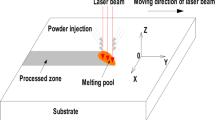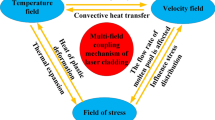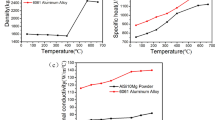Abstract
To obtain more accurate geometric features of laser cladding layer repair for Invar alloy, an integrated model of the laser cladding repair process is formulated and evaluated. The model evaluates geometric features, namely, the width, contact angle or height of cladding layer, and dilution rate for a given laser power, scanning speed, powder feed rate, and height of the cladding layer or contact angle. First, a model is presented that can ensure the powder from the nozzles melts completely before it hits the base material. Second, a model of the geometric characteristics of cladding layer is developed to determine how the scanning speed and powder feed rate affect the contact angle. Third, a model of the dilution rate is provided to account for the energy absorbed by the base material. The laser power which filters through the powder is absorbed by the base material. Then, the laser power is reflected by the base material, attenuated by the powder, and partly deflected back to the base material. In addition, the powder absorbs part of the attenuated power and surrenders it to the base material. Incidentally, the microstructure of the cladding layer responds to the super-cooling degree of the liquid-solid interface. The results show that the mathematical model is well supported by the experimental results.
Similar content being viewed by others
References
Gu DD, Meiners W, Wissenbach K, Poprawe R (2013) Laser additive manufacturing of metallic components: materials, processes and mechanisms. Int Mater Rev 57(3):133–164
Weng F, Chen C, Yu H (2014) Research status of laser cladding on titanium and its alloys: a review. Mater Des 58(6):412–425
Sexton L, Lavin S, Byrne G, Kennedy A (2002) Laser cladding of aerospace materials. J Mater Process Technol 122(1):63–68
Wang X, Sun W, Chen Y, Zhang J, Huang Y, Huang H (2018) Research on trajectory planning of complex curved surface parts by laser cladding remanufacturing. Int J Adv Manuf Technol 96(5–8):2397–2406
Shepeleva L, Medres B, Kaplan WD, Bamberger M, Weisheit A (2000) Laser cladding of turbine blades. Surf Coat Technol 125(1):45–48
Xu L, Cao H, Liu H, Zhang Y (2017) Study on laser cladding remanufacturing process with FeCrNiCu alloy powder for thin-wall impeller blade. Int J Adv Manuf Technol 90(5–8):1383–1392
Penaranda X, Moralejo S, Lamikiz A, Figueras J (2017) An adaptive laser cladding methodology for blade tip repair. Int J Adv Manuf Technol 92(3):1–7
Yu J, Kim D (2018) Effects of welding current and torch position parameters on minimizing the weld porosity of zinc-coated steel. Int J Adv Manuf Technol 95(1–4):551–567
Moralejo S, Penaranda X, Nieto S, Barrios A, Arrizubieta I, Tabernero I, Figueras J (2017) A feedforward controller for tuning laser cladding melt pool geometry in real time. Int J Adv Manuf Technol 89(1–4):1–11
Farshidianfar MH, Khajepour A, Gerlich A (2016) Real-time control of microstructure in laser additive manufacturing. Int J Adv Manuf Technol 82(5–8):1173–1186
Zheng H, Cong M, Dong H, Liu Y, Liu D (2017) CAD-based automatic path generation and optimization for laser cladding robot in additive manufacturing. Int J Adv Manuf Technol 92(9–12):1–10
Song L, Bagavath-Singh V, Dutta B, Mazumder J (2012) Control of melt pool temperature and deposition height during direct metal deposition process. Int J Adv Manuf Technol 58(1–4):247–256
Fathi A, Khajepour A, Toyserkani E, Durali M (2007) Clad height control in laser solid freeform fabrication using a feedforward PID controller. Int J Adv Manuf Technol 35(3–4):280–292
Alam MK, Urbanic RJ, Nazemi N, Edrisy A (2018) Predictive modeling and the effect of process parameters on the hardness and bead characteristics for laser-cladded stainless steel. Int J Adv Manuf Technol 94(1–4):397–413
Cheng YH, Cui R, Wang HZ, Han ZT (2017) Effect of processing parameters of laser on microstructure and properties of cladding 42CrMo steel. Int J Adv Manuf Technol 96(5–8):1–10
Verdi D, Múnez CJ, Garrido MA, Poza P (2017) Process parameter selection for Inconel 625-Cr3C2 laser cladded coatings. Int J Adv Manuf Technol 92(5–8):1–10
Cheikh HE, Courant B, Hascoët JY, Guillén R (2012) Prediction and analytical description of the single laser track geometry in direct laser fabrication from process parameters and energy balance reasoning. J Mater Process Technol 212(9):1832–1839
Picasso M, Marsden CF, Wagniere JD, Frenk A, Rappaz M (1994) A simple but realistic model for laser cladding. Metall Mater Trans B 25(2):281–291
Ni L, Liu J, Wu Y, Yan C (2011) Optimization of laser cladding process variables based on neural network and particle swarm optimization algorithms. Chin J Lasers 38(2):1–6
Lalas C, Tsirbas K, Salonitis K, Chryssolouris G (2007) An analytical model of the laser clad geometry. Int J Adv Manuf Technol 32:34–41
Cheikh HE, Courant B, Branchu S, Hascoët JY, Guillén R (2012) Analysis and prediction of single laser tracks geometrical characteristics in coaxial laser cladding process. Opt Lasers Eng 50:413–422
Hofman JT, Lange DF, Pathiraj B (2011) FEM modeling and experimental verification for dilution control in laser cladding. J Mater Process Technol 211:187–196
Caiazzo F, Alfieri V (2018) Laser-aided directed energy deposition of steel powder over flat surfaces and edges. Materials 11(3)
Zeng C, Tian W, Liao WH, Liang H (2013) Study of laser cladding thermal damage: a quantified microhardness method. Surf Coat Technol 236(24):309–314
Funding
Financial support of the project was received from the open fund of the State Key Laboratory of Additive Manufacturing, China academy of engineering physics (ZM17002) and the Key Laboratory of High and New Technology Project of Changzhou (CM20183004).
Author information
Authors and Affiliations
Corresponding author
Additional information
Publisher’s note
Springer Nature remains neutral with regard to jurisdictional claims in published maps and institutional affiliations.
Rights and permissions
About this article
Cite this article
Zhu, S., Chen, W., Ding, L. et al. A mathematical model of laser cladding repair. Int J Adv Manuf Technol 103, 3265–3278 (2019). https://doi.org/10.1007/s00170-019-03588-3
Received:
Accepted:
Published:
Issue Date:
DOI: https://doi.org/10.1007/s00170-019-03588-3




